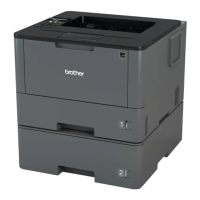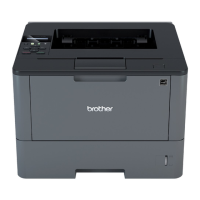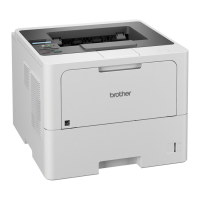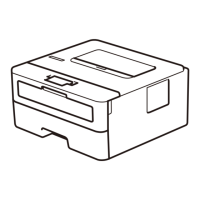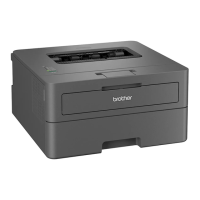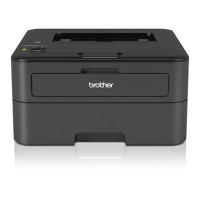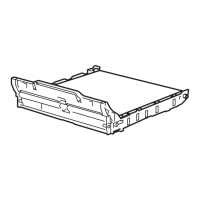Do you have a question about the Brother HL-L5100DN and is the answer not in the manual?
Lists the specific printer models covered by this user guide.
Explains symbols, icons, and text conventions used throughout the guide.
Lists trademarks and registered trademarks of Brother and other companies.
Provides crucial information regarding product usage, country restrictions, and software versions.
Covers essential checks and firewall considerations before operating the machine.
Identifies and labels the external parts of the Brother machine for different models.
Explains the functions of the control panel components and buttons for various models.
Details the home screen, icons, and navigation elements of the touchscreen LCD.
Provides step-by-step instructions on navigating menus and changing machine settings via the touchscreen.
Guides users on how to launch the Brother Utilities application on Windows for accessing machine functions.
Provides instructions for removing Brother software and drivers from a Windows computer.
Explains how to load paper into the main paper tray and the multi-purpose tray.
Covers changing paper size, type, and enabling the check paper size feature.
Details how to adjust the 2-sided tray size for correct paper feeding during duplex printing.
Shows the maximum unprintable areas on paper sizes and warns against printing in these zones.
Advises on types of paper to avoid and how to handle special paper for optimal performance.
Covers various printing options and procedures from a Windows computer.
Details printing procedures and options available for Macintosh users.
Explains how to use the Carbon Copy function for printing multiple copies on different paper types.
Provides instructions on how to cancel a print job from the machine's control panel.
Guides on performing a test print to check print quality and machine status.
Recommends using the installation CD-ROM for network setup and provides an overview of network features.
Explains how to configure and manage network settings using management utilities like Web Based Management.
Offers various methods for connecting the machine to a wireless network, including WPS and Ad-Hoc modes.
Covers features like printing network configuration reports and WLAN status reports.
Provides details on Gigabit Ethernet and resetting network settings to factory defaults.
Explains how to use the Setting Lock feature to prevent unauthorized access to machine settings.
Introduces various network security protocols and features for data protection and access control.
Lists common error and maintenance messages and provides solutions for each.
Explains how to identify and clear paper jams from various locations within the machine.
Addresses common printing issues like no printout, garbage print, or missing text.
Offers recommendations and solutions for various print quality issues like faint print or ghosting.
Covers troubleshooting steps for network connectivity issues and error messages.
Addresses less common issues like the machine not turning on or inability to print specific file types.
Guides users on how to check machine serial number, firmware version, and page counts.
Explains how to reset network settings or perform a full factory reset of the machine.
Lists supplies like toner cartridges and drum units and when they need replacement.
Provides instructions on cleaning the machine's exterior and interior parts, including specific components.
Guides users on how to check the approximate remaining life of various machine parts and supplies.
Details the procedures for packing and shipping the machine, including specific instructions for toner cartridges.
Details how to customize settings and features directly on the machine's LCD.
Explains how to manage machine settings remotely using Web Based Management or other utilities.
Lists the technical specifications of the Brother machine, including dimensions and power consumption.
Provides instructions on inputting characters and making corrections using the machine's LCD keyboard.
Lists compatible supplies like toner cartridges and drum units with their model names and approximate page yields.
Lists available optional accessories such as lower trays and mailbox units for the machine.
Lists the specific printer models covered by this user guide.
Explains symbols, icons, and text conventions used throughout the guide.
Lists trademarks and registered trademarks of Brother and other companies.
Provides crucial information regarding product usage, country restrictions, and software versions.
Covers essential checks and firewall considerations before operating the machine.
Identifies and labels the external parts of the Brother machine for different models.
Explains the functions of the control panel components and buttons for various models.
Details the home screen, icons, and navigation elements of the touchscreen LCD.
Provides step-by-step instructions on navigating menus and changing machine settings via the touchscreen.
Guides users on how to launch the Brother Utilities application on Windows for accessing machine functions.
Provides instructions for removing Brother software and drivers from a Windows computer.
Explains how to load paper into the main paper tray and the multi-purpose tray.
Covers changing paper size, type, and enabling the check paper size feature.
Details how to adjust the 2-sided tray size for correct paper feeding during duplex printing.
Shows the maximum unprintable areas on paper sizes and warns against printing in these zones.
Advises on types of paper to avoid and how to handle special paper for optimal performance.
Covers various printing options and procedures from a Windows computer.
Details printing procedures and options available for Macintosh users.
Explains how to use the Carbon Copy function for printing multiple copies on different paper types.
Provides instructions on how to cancel a print job from the machine's control panel.
Guides on performing a test print to check print quality and machine status.
Recommends using the installation CD-ROM for network setup and provides an overview of network features.
Explains how to configure and manage network settings using management utilities like Web Based Management.
Offers various methods for connecting the machine to a wireless network, including WPS and Ad-Hoc modes.
Covers features like printing network configuration reports and WLAN status reports.
Provides details on Gigabit Ethernet and resetting network settings to factory defaults.
Explains how to use the Setting Lock feature to prevent unauthorized access to machine settings.
Introduces various network security protocols and features for data protection and access control.
Lists common error and maintenance messages and provides solutions for each.
Explains how to identify and clear paper jams from various locations within the machine.
Addresses common printing issues like no printout, garbage print, or missing text.
Offers recommendations and solutions for various print quality issues like faint print or ghosting.
Covers troubleshooting steps for network connectivity issues and error messages.
Addresses less common issues like the machine not turning on or inability to print specific file types.
Guides users on how to check machine serial number, firmware version, and page counts.
Explains how to reset network settings or perform a full factory reset of the machine.
Lists supplies like toner cartridges and drum units and when they need replacement.
Provides instructions on cleaning the machine's exterior and interior parts, including specific components.
Guides users on how to check the approximate remaining life of various machine parts and supplies.
Details the procedures for packing and shipping the machine, including specific instructions for toner cartridges.
Details how to customize settings and features directly on the machine's LCD.
Explains how to manage machine settings remotely using Web Based Management or other utilities.
Lists the technical specifications of the Brother machine, including dimensions and power consumption.
Provides instructions on inputting characters and making corrections using the machine's LCD keyboard.
Lists compatible supplies like toner cartridges and drum units with their model names and approximate page yields.
Lists available optional accessories such as lower trays and mailbox units for the machine.
| Color | No |
|---|---|
| N-up printing | 2, 4, 9, 16, 25 |
| Duplex printing | Yes |
| Print technology | Laser |
| Maximum resolution | 1200 x 1200 DPI |
| Duplex printing mode | Auto |
| Time to first page (black, normal) | 7.2 s |
| Print speed (black, normal quality, A4/US Letter) | 40 ppm |
| PCL fonts | 66 |
| Printer fonts | Bitmap, PostScript |
| Printing colors | Black |
| Maximum duty cycle | 50000 pages per month |
| Recommended duty cycle | 0 - 3500 pages per month |
| Number of print cartridges | 1 |
| Page description languages | BR-Script 3, Epson FX, IBM ProPrinter, Microsoft XPS, PCL 6, PDF 1.7, PostScript 3 |
| Display | LCD |
| Certification | Nordic Swan |
| Product color | Graphite |
| Market positioning | - |
| Display number of lines | 1 lines |
| AC input frequency | 50 - 60 Hz |
| Power consumption (off) | 0.04 W |
| Power consumption (standby) | 32 W |
| Power consumption (printing) | 620 W |
| Energy Star Typical Electricity Consumption (TEC) | 1.763 kWh/week |
| Processor model | A9 |
| Processor family | ARM Cortex |
| Maximum internal memory | - MB |
| Sound power level (standby) | 34 dB |
| Sound pressure level (printing) | 52 dB |
| Sound pressure level (quiet mode) | 50 dB |
| Paper input type | Cassette, Paper tray |
| Total input capacity | 250 sheets |
| Total output capacity | 150 sheets |
| Multi-Purpose tray input capacity | 50 sheets |
| Custom media width | 76.2 - 215.9 mm |
| Custom media length | 127 - 355.6 mm |
| Paper tray media types | Plain paper, Recycled paper, Thick paper, Thin paper |
| Paper tray media weight | 60 - 120 g/m² |
| Non-ISO print media sizes | Executive (184 x 267mm), Folio (media size), Letter (media size), Legal (media size) |
| ISO A-series sizes (A0...A9) | A4, A5, A6 |
| Duplex media weight (imperial) | 60 - 120 lbs |
| Multi-purpose tray media types | Bond paper, Envelopes, Labels, Letterhead, Plain paper, Recycled paper, Thick paper, Thicker paper, Thin paper |
| Maximum ISO A-series paper size | A4 |
| Multi-Purpose Tray media weight | 60 - 200 g/m² |
| Storage temperature (T-T) | 0 - 40 °C |
| Operating temperature (T-T) | 10 - 32 °C |
| Storage relative humidity (H-H) | 35 - 85 % |
| Operating relative humidity (H-H) | 20 - 80 % |
| Cabling technology | 10/100Base-T(X) |
| Security algorithms | 802.1x RADIUS, EAP-FAST, EAP-MD5, EAP-TLS, EAP-TTLS, HTTPS, IPPS, IPSEC, PEAP, SMTP-AUTH, SNMP, SSL/TLS |
| Ethernet LAN data rates | 10, 100 Mbit/s |
| Mobile printing technologies | Apple AirPrint, Brother iPrint & Scan, Google Cloud Print, Mopria Print Service |
| Supported network protocols (IPv4) | ARP, RARP, BOOTP, DHCP, APIPA(Auto IP), WINS/NetBIOS name resolution, DNS Resolver, mDNS, LLMNR responder, LPR/LPD, Custom Raw Port/Port9100, IPP/IPPS, FTP Server, TELNET Server, HTTP/HTTPS Server, TFTP Client & Server, SMTP Client, SNMPv1/v2c/v3, ICMP, Web Services (Print), CIFS Client, SNTP Client |
| Supported network protocols (IPv6) | NDP, RA, DNS resolver, mDNS, LLMNR responder, LPR/LPD, Custom Raw Port/Port9100, IPP/IPPS, FTP Server, TELNET Server, HTTP/HTTPS Server, TFTP Client & Server, SMTP Client, SNMPv1/v2c, ICMPv6, Web Services (Print), CIFS Client, SNTP Client |
| Standard interfaces | Ethernet, USB 2.0 |
| USB 2.0 ports quantity | USB 2.0 ports have a data transmission speed of 480 Mbps, and are backwards compatible with USB 1.1 ports. You can connect all kinds of peripheral devices to them. |
| Package depth | 450 mm |
| Package width | 485 mm |
| Package height | 377 mm |
| Package weight | 13000 g |
| Sustainability certificates | Blue Angel, ENERGY STAR |
| Server operating systems supported | Windows Server 2003, Windows Server 2008, Windows Server 2012 |
| Windows operating systems supported | Windows 10, Windows 10 Education, Windows 10 Education x64, Windows 10 Enterprise, Windows 10 Enterprise x64, Windows 10 Home, Windows 10 Home x64, Windows 10 Pro, Windows 10 Pro x64, Windows 7, Windows 7 Enterprise, Windows 7 Enterprise x64, Windows 7 Home Basic, Windows 7 Home Basic x64, Windows 7 Home Premium, Windows 7 Home Premium x64, Windows 7 Professional, Windows 7 Professional x64, Windows 7 Starter, Windows 7 Starter x64, Windows 7 Ultimate, Windows 7 Ultimate x64, Windows 8, Windows 8 Enterprise, Windows 8 Enterprise x64, Windows 8 Pro, Windows 8 Pro x64, Windows 8 x64, Windows 8.1, Windows 8.1 Enterprise, Windows 8.1 Enterprise x64, Windows 8.1 Pro, Windows 8.1 Pro x64, Windows 8.1 x64, Windows Vista Business, Windows Vista Business x64, Windows Vista Enterprise, Windows Vista Enterprise x64, Windows Vista Home Basic, Windows Vista Home Basic x64, Windows Vista Home Premium, Windows Vista Home Premium x64, Windows Vista Ultimate, Windows Vista Ultimate x64 |
| Email protocols | SMTP |
| Harmonized System (HS) code | 84433210 |
| Depth | 388 mm |
|---|---|
| Width | 373 mm |
| Height | 255 mm |
